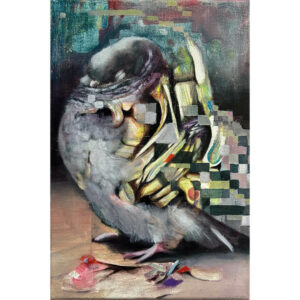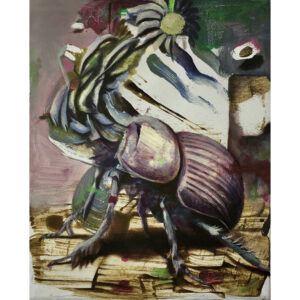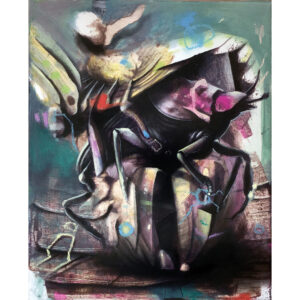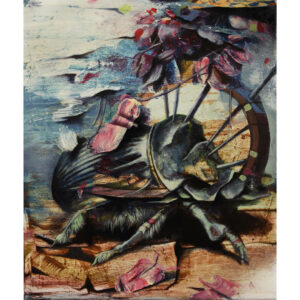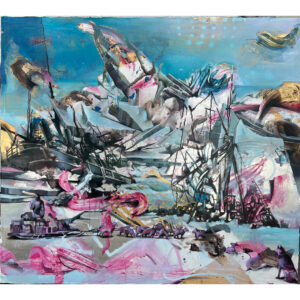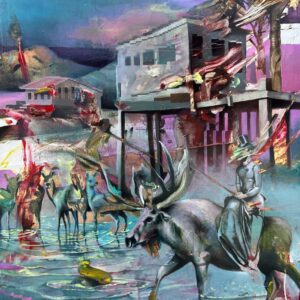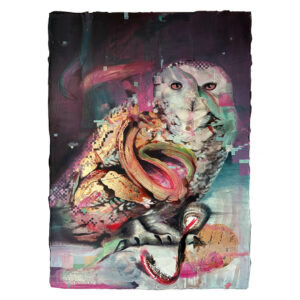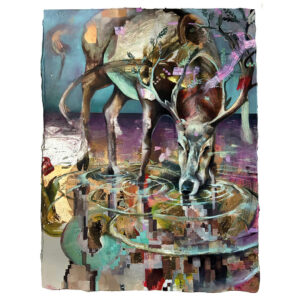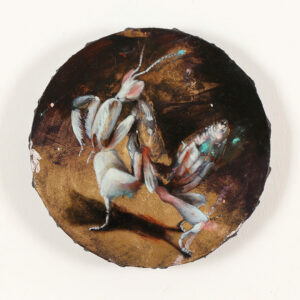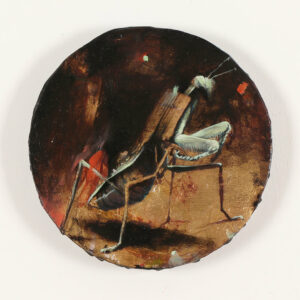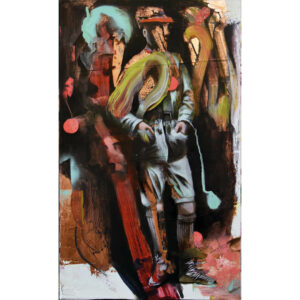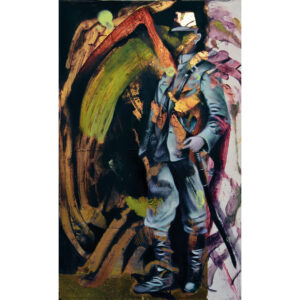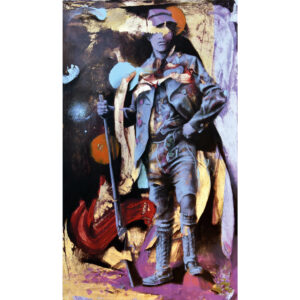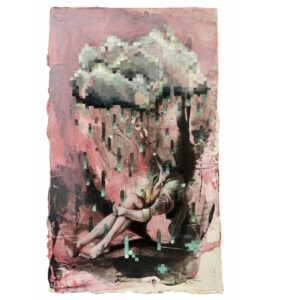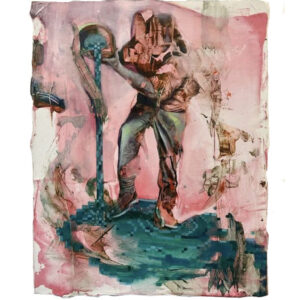Benjamin Burkard
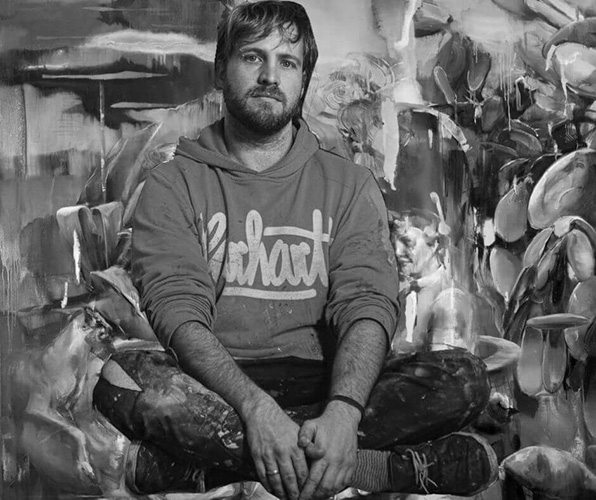
Benjamin Burkard’s paintings are characterized by the elaboration of deep space, representational objects, especially people and animals, are carved out of the abstract colourfulness. The young artist, who has also studied biology, explores his compositions as a pictorial narrative ready to comment on society and humanity through his characteristic use of historical references, the pixel element and the diffuminnation of faces.
Burkard’s works are already part of numerous private and public collections. Some of his works are currently on display at the Museum modern Art in Hünfeld.
MORE INFORMATION
30.11.86 born in Kandel (Rheinland-Pfalz). 2006 graduated from the Europa Gymnasium in Wörth. Since 2007 he has been studying art and biology at the University of Landau.
Benjamin Burkard’s mostly large-format works confront the viewer powerfully and with intense coloring. They challenge the viewer in their diversity and point to ambiguous messages in surreal form. The artist’s starting point is initially his enormous pool of images from magazines, photographs and sketches. He recorded individual ideas and fragments in a constant stream of new books until they finally matured into the basis for his paintings. The drawings stem from his interest in mechanics, science, nature and, to a large extent, people. Detailed compositional sketches, notes from language and literature, as well as impressions of his immediate surroundings serve Benjamin Burkhard as the foundation for his paintings. Contrary to appearances, nothing is left to chance, and yet the spontaneous color flow of the impulsive commission repeatedly finds its way into the composition. The artist deliberately places the layers of color on top of each other and initially develops an abstract basic structure from this. Light colors lie on top of darker ones, opaque surfaces block the view into the depths and, in addition, structures applied with a broad brush in a glazed manner allow the underlying layers to emerge visibly. It is precisely this diversity of veiling and opening that creates an incredible tension and significantly reinforces the intense impression of the haptics of the pictures. Their surfaces seem almost tangible to the observer and give the individual areas a constantly changing texture. Drops, gradient lines, small scratches and even open areas of the canvas: the various traces of this intensive painting process may well disappear again as the work progresses, but they often remain until the end and emphasize the dynamism of the design. From the mostly diffuse, unframed outer edges of the canvases, the colors seem to flow into the interior of the composition and condense there. At their core, they develop different areas of central importance. These centers of highest concentration are increasingly found in the horizontal or vertical central axis, but can also be moved to the edges of the picture from time to time. With a tremendous force of color, the intense dynamics of movement and counter-movement, the painting undergoes a new work process. In the course of developing this deep space, figurative objects, primarily people and animals, are worked out of the abstract colourfulness. Inevitably, these elements, some of which achieve almost photographic accuracy, attract the viewer’s attention. Only to move further components visually from the background and form the narrative unity of the paintings. At second glance, a complex pictorial structure of additively assembled fragments opens up, which are held together like a closed organism by various architectural structures, as if by the cloak of a dwelling.
Even if he is not visible, only limbs hint at his presence, man plays a central role within this artistically created ecosystem.
Curriculum vitae
30.11.86 born in Kandel
2006
Abitur at the Europa Gymnasium in Wörth
since 2007
Studies at the University of Landau, Art and Biology Pupil of Günther Berlejung
2008
Heinrich von Zügel scholarship for painting / Wörth 2009 Art in construction – painting of the Kandel sewage treatment plant
2012
Winner of the Germany-wide competition “Young Art in the Villa” | Neustadt a.d. Weinstraße
2014
Item Art Prize for Painting “Innovation with System” 2014 2015 Funding from the Joseph David Foundation
Heinrich von Zügel Prize for Painting Albert Haueisen Sponsorship Award
Mural “Ecosystem”, Mannheim | 3.5 x 200m 2016 Shortlist Phoenix Art Prize | Top Ten, 2nd place
Förderkoje Kunst/Mitte Magdeburg
Winner of the Fisher&collegen Art Prize Stuttgart 2020 Finalist Phönix Art Prize
Artist in Residence – Laos, Phönix Art Prize Förderkoje Talente – Stroke Art Fair, Munich
2021
Neustart Culture catalogue funding programme
Exhibitions
2023
- Regensburg, Art Affair Gallery “Edelbleich”
2017
- Karlsruhe / art Karlsruhe, Gallery Luzia Sassen one-artist-show
- Köln / Gallery 30works, „Fourplay“
- Wien / Gallery Charity, alte Post
- Berlin / Junge Kunst Berlin, „panting affairs“
- Berlin / Collectors Club Berlin
- Weinheim / Förderverein Weinheim, „Wortmalerei trifft Maschinenmalerei“
- Berlin / Gallery weekend, Junge Kunst Berlin
- Biel / Galerie 95 „Wunderwerke“
- Salzburg / Art Salzburg, Gallery of Hofsteig
- Konstanz / Art Bodensee, Gallery of Hofsteig
- Kaiserslautern / Förderverein Kaiserslautern, „Talente“
- Berlin / Villa Löwenpalais, Junge Kunst Berlin, „Kybernetische Renaissance“
- Köln / 30works II, Gallery of 30works schöne neue Welt
2016
- Karlsruhe / art Karlsruhe
- Gladbeck / Gallery alte Spedition „Junge Kunst im Ruhrgebiet“
- Köln / Gallery Luzia Sassen
- Rheinzabern / Artelier21 “Nimmerland“
- Berlin / „Young Selections“ Foundation Villa Königsfeld
- Köln / Blooom converging show, DieHO-Gallery
- Frankfurt /Galerie Hühsam
- Berlin / „Painting Delight“, Junge Kunst Berlin
- Lübeck / Overbeck Gesellschaft, Junge Kunst Berlin
- Stuttgart / Fisher-collegen Kunstpreis 2016
- Magdeburg / Kunst Mitte, Förderkoje
2015
- Bad Bergzabern / Art gallery of the castle „ungewollte Wunder“
- Köln / Gallery Sassen
- Frankfurt / Gallery Thomas Hühsam
- Ludwigshafen / City museum
- Ulm / Item-Werk „Ingenium“
- Büdelsdorf / Kunstwerk Carlshütte, NordART 2015
- Neustadt / Art Imaginär
- Amsterdam / Affordable Art Fair
2014
- Worms / Exhibition of Kunstpreis Alzey-Worms
- Ulm / Item-Werk, Exhibition of Item Kunstpreis 2014
- Kaiserslautern / Museum Pfalzgalerie „Apocalypse Now!”
- Gladbeck / Galerie Alte Spedition
- Pulheim / 26. Kunsttage Rhein Erft
- Essen / Contemporary Art Ruhr
- Windeck / Art’pul Windeck
2013
- Offenbach a.M. / Galerie Hühsam
- Köln / 25. Kunsttage Rhein-Erft
- Neustadt a.d.Weinstraße / Villa Böhm „Naturzustand“
- Karlsruhe / Karlsruher lange Nacht der Museen (KaMuNa)
- Rheinzabern / Galerie Artelier 21 „Artes Mechanicae“
- Lorient / 50 Jahre Les ateliers ouverts
- Gladbeck / Exhibition of Wilhelm-Zimolong Förderpreis
- Garmisch Patenkirchen / Exhibition of Langmatz Kunstpreis
- Kaiserslautern / Museum Pfalzgalerie „Bildlabor“
2012
- Viernheim / Humboldt Gallery „Stadt Land Mensch“
- Neustadt / Moments Art Gallery „Nexus“
- Tschchesztowa / ADJ Galleria
- Wörth / Gallery altes Rathaus „der mobile Mensch“
- Kaiserslautern / Pfalzgalerie – Exhibition of Pfalzpreis für Malerei
Edelbleich in der Art Affair galerie – Art Affair Galerie from 21. 02.2023
Interview Benjamin Burkard – Art Affair Galerie from 20.02.2023
Vernissage Edelbleich, Benjamin Burkard in der Art Affair Galerie Regensburg – Art Affair Galerie vom 16.02.2023
Künstler-Portrait Benjamin Burkard – Galerie Thomas Hühsam from 31.05.2021
Mein pandemischer Monolog (Teil 3) – Burkard Benjamin from 08.02.2021
Mein pandemischer Monolog (Teil 1) – Burkard Benjamin from 12.05.2020
30works stellt vor: Benjamin Burkard, Maler – 30works from 04.06.2020
TEASER Making OF – Burkard Benjamin vom 01.05.2020
Der Alligatoah aus KandelBenjamin-Alligatoah– Die Rheinpfalz
Die Entdeckung eines spannenden jungen Künstlers: Benjamin Burkard in Regensburg – PNP.de vom 15.02.2023
Galerien in Regensburg –TVA Blitzlicht from 14. Februar 2023
Junger Künstler bei Art Affair: Krächzendes Echo im Sonnenlicht – Mittelbayerische.de from 13. Februar 2023
Benjamin Burkards malerischer Grenzverkehr nach Österreich – Die Rheinpfalz. from 10.03.2021 Kreis Germersheim
Keine Grenze für die Kunst – Kandeler Benjamin Burkhardt und Österreicher Georg Pummer wagen spannendes Experiment – pfalz-express.de from 27. Februar 2021
Ausstellung von Benjamin Burkard in Frankenhal, Ende dem Anfang – wochenblatt-reporter.de from 16. Mai 2019
Kunst Zugunsten des Arte Casimir-Sozialfonds, Sieben auf einen Streich – wochenblatt-reporter.de from 27. September 2019

